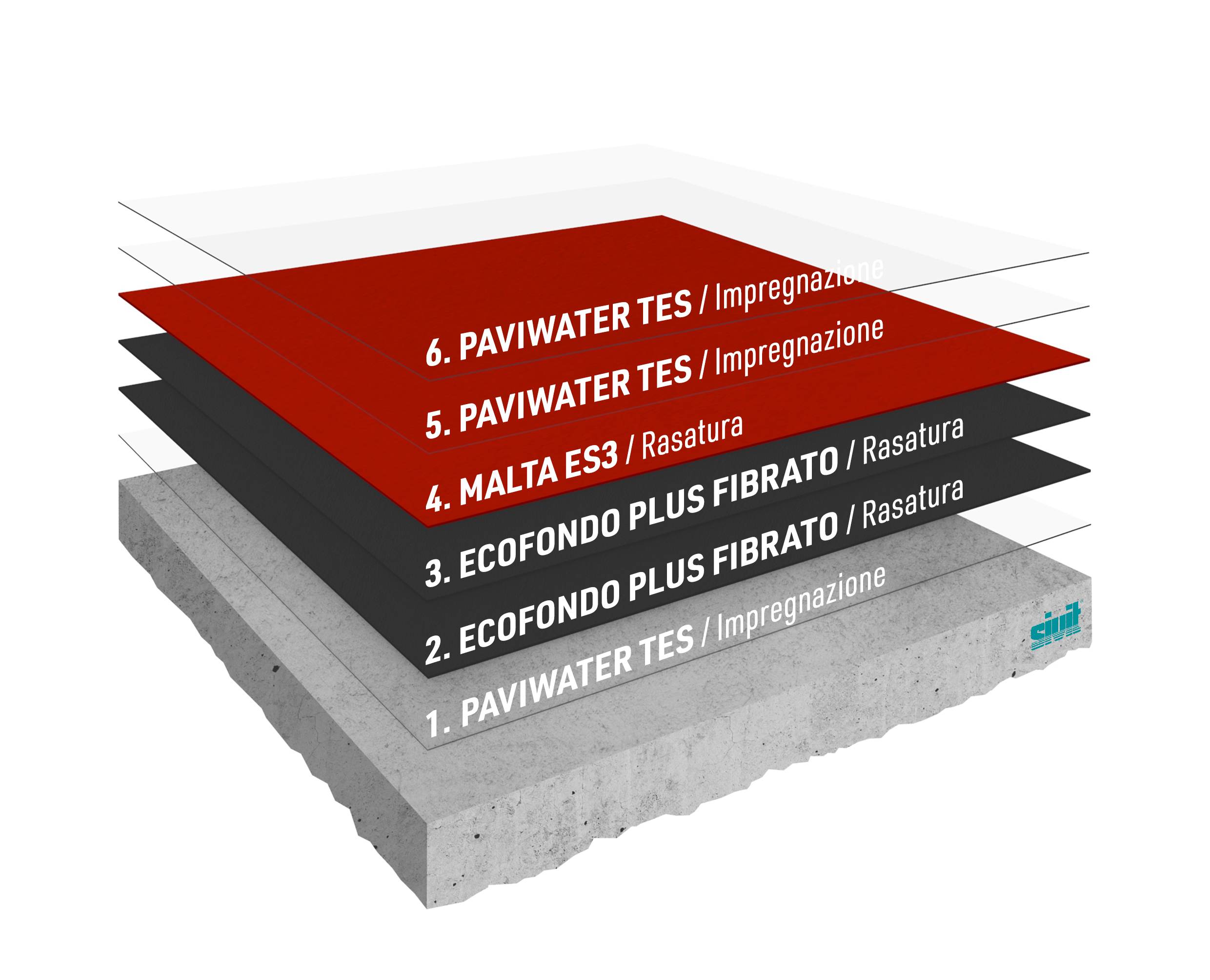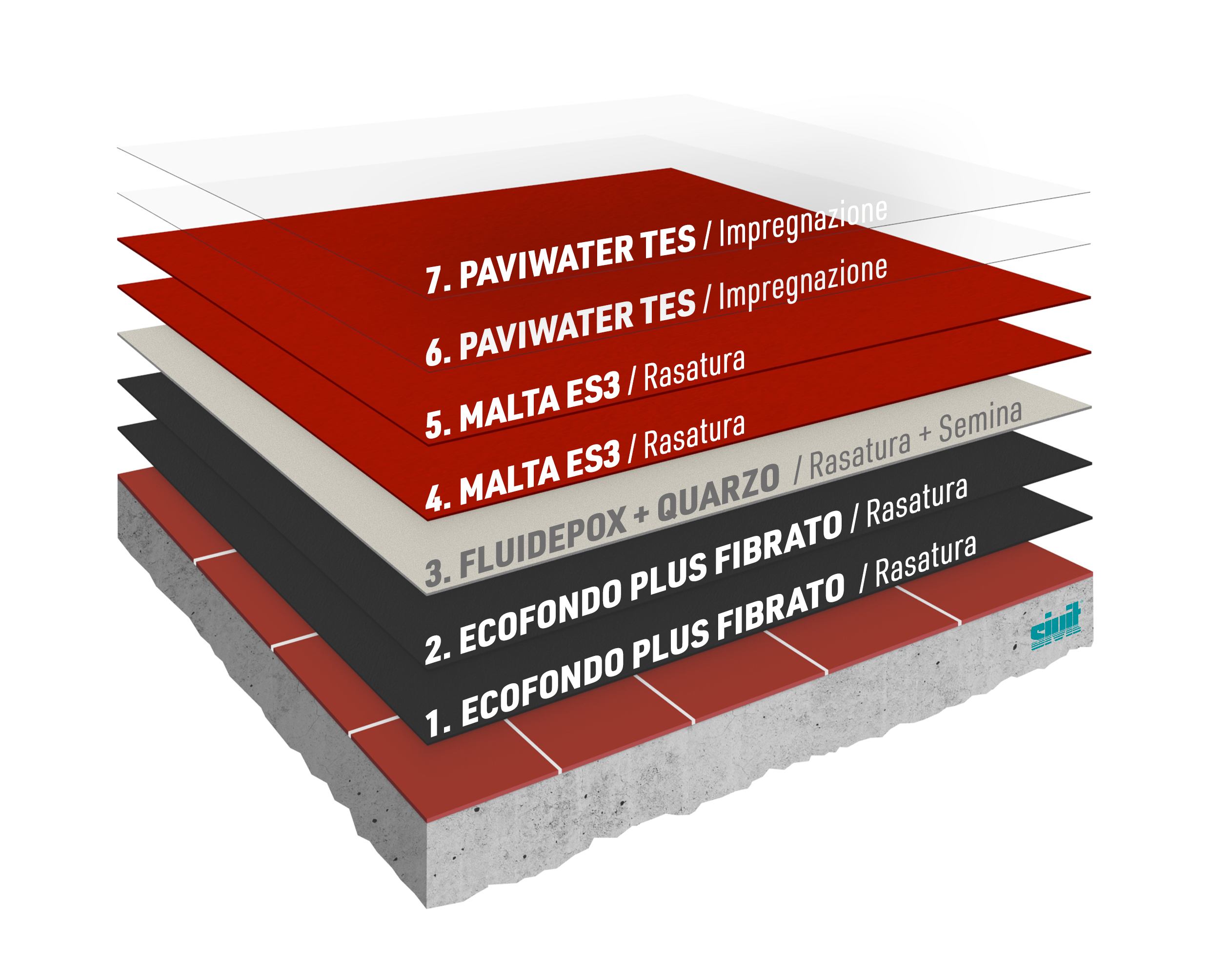PAVIWATER® TES A+B
Trasparente epossidico in emulsione acquosa a basso ingiallimento
Utilizzato come finitura trasparente su pavimenti in cemento, impregnante antipolvere, protettivo di pavimenti stampati o consolidante trasparente, Paviwater TES offre un’ottima resistenza alle atmosfere industriali.
Presenta buona resistenza alle sollecitazioni meccaniche, ai solventi, all’azione dei raggi UV e può essere diluito in acqua per ridurne la viscosità.
Tipologia: Fondi, Consolidanti, Primer
Descrizione
Sistema epossidico bicomponente, a base di resina epossidiche ed amminiche in dispersione acquosa. Il prodotto viene fornito con un alto contenuto di solidi: la viscosità può essere abbassata sensibilmente diluendo con acqua.
La pellicola che si ottiene presenta buone caratteristiche meccaniche, buone resistenze ai solventi, ottima resistenza alla luce.
Utilizzi
Finitura trasparente di pavimentazioni e manufatti cementizi in esterno.
Impregnante antipolvere per esterni.
Protezione di pavimenti stampati e consolidamento trasparente.
Supporto
Il sottofondo deve possedere una resistenza minima alla compressione di 25 N/mm2 e a trazione di 1,5 N/mm2
Preparazione del supporto
Se il cls è di nuova costruzione si dovrà attendere la maturazione completa.
La superficie si dovrà presentare solida, assorbente ed esente da presenza di oli, tensioattivi, acqua, polvere. Eventuali parti inconsistenti dovranno essere rimosse. Le pavimentazioni vanno trattate meccanicamente, mediante carteggiatura.
Eventuali buchi e lievi anomalie, possono essere riparati con PAVIRAPID o SIVITCOL.
Applicazione

Al momento dell’applicazione unire i due componenti in un unico recipiente e miscelare con cura per 2 minuti, utilizzando adeguata attrezzatura (trapano con elica).
Aggiungere lentamente sotto agitazione l’acqua di diluizione, rimescolare il prodotto per 1 minuto ed utilizzare entro il tempo di utilizzo.
PAVIWATER TES può trovare la sua applicazione come:
Finitura trasparente:
- in una sola ripresa, previa diluizione di una parte di (A+B) e una parte di acqua, per un consumo di prodotto di circa 0,100 kg/m2
- in due riprese, previa diluizione di una parte di (A+B) e 3 parti di acqua, per la 1° ripresa, e una parte di (A+B) e 1,5 parti di acqua, per la 2° ripresa, per un consumo di prodotto di circa 0,050 kg/m2 per ciascuna ripresa.
Impregnante antipolvere:
applicare due riprese per un consumo di prodotto di circa 0,050 kg/m2 (per ciascuna ripresa):
- 1° ripresa - una parte (A+B) + 3 parti di acqua
- 2° ripresa - una parte (A+B) + 1,5 parti di acqua
Prodotto ad uso professionale, l’acquirente si impegna a seguire tassativamente le avvertenze sopra riportate nell’applicazione del prodotto acquistato e le indicazioni della scheda di sicurezza.
Specifiche tecniche
| DATI PRODOTTO | |
|---|---|
| Colore | Trasparente giallognolo |
| Consumo | Come impregnante: circa 0,050 kg/m2 Come finitura: 0,100-120 kg/m2 |
| Peso specifico (a 25°C): miscela (A+B) |
1,10 +/– 0,05 g/ml |
| Viscosità (a 25°C): miscela (A+B) |
800-1.300 mPa•s (spindle 2,rpm 5) |
| Residuo secco (A+B) | 61% in peso |
| VOC pronto uso (D.lgs 161/06) | 20 g/l Cat.A/j. Pittura bicomponente ad alte prestazioni (BA). |
| Punto di infiammabilità | Non applicabile |
| Solvente per la pulizia attrezzi | Acqua |
| Magazzinaggio | 12 mesi conservare in luogo asciutto ad una temperatura compresa tra i 5°C ed i 35°C |
| DATI APPLICAZIONE E TEMPI | |
|---|---|
| Rapporto di miscela | in peso: A=100, B=61 |
| Pot-life (50% U.R.) | a 25°C 120 min |
| Secco al tatto (50% U.R.) | a 15°C 18-22 ore a 25°C 4-6 ore a 30°C 2,5-3,5 ore |
| Pedonabile (50% U.R.) | a 25°C da 14 a 36 ore |
| Ricopertura (50% U.R.) | a 25°C da 14 a 36 ore |
| Trafficabile (50% U.R.) | a 25°C 3 giorni |
| Indurimento in profondità (50% U.R.) | a 25°C 7 giorni |
| Condizioni ambientali d’uso | Temperature comprese tra i +10°C e i +30°C e U.R. < 70%(*) |
| Manutenzione rivestimento | Per le operazioni di pulizia utilizzare detergenti neutri |
| DATI TECNICI PRESTAZIONALI | |
|---|---|
| Aspetto | Trasparente |
| Gloss 60° | 60-65 (*) |
| Resistenza all’abrasione norma UNI 8298-9 | 60-70 mg (TABER Mola CS-17-1000giri - 1000 g di peso) |
| (*) Il grado di brillantezza del prodotto PAVIWATER TES applicato è influenzato da diversi fattori: temperatura del materiale, umidità ambientale, temperatura di applicazione e porosità del supporto. | |



